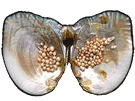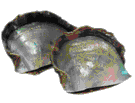Pearl Types
Natural vs. Cultured Pearls
The term "natural" is given to those pearls formed inside a
mollusk without intervention by people. The chances of someone coming across a
perfectly rounded natural pearl are extremely slim, which is why most pearls on
the market today are in fact "cultured" pearls.
Cultured pearls are what happens when man steps in. Acting much like a chef with
a recipe, a pearl farmer coaxes the process along by placing the proper
ingredients, so to speak, into a mollusk to then naturally form a perfectly
shaped pearl.
Freshwater vs. Saltwater Pearls
Basically, all cultured pearls can be listed in two categories: Freshwater Pearls
and Saltwater Pearls. Freshwater pearls are grown primarily in man-made lakes and
reservoirs in China. Saltwater pearls, which include Akoya, Tahitian and South Sea, are
grown in bays, inlets and atolls in many places around the world. Saltwater pearls are
considered more valuable than freshwater pearls, although rare and very high-quality
freshwater pearls can be exceedingly valuable.
Freshwater Pearls |
 |
Freshwater pearls are best known for their wide range of shapes, sizes, and colors, and their attractive prices. They
are produced by the Hyriopsis cumingi, Hyriopsis schlegeli, and Cristaria plicata mussels,
which live in lakes and rivers in China and Japan. Most of the Chinese freshwater pearl farming takes place within
about 480 km (300 miles) of Shanghai. The mussels are grafted with pieces of mantle tissue, resulting in pearls of solid
nacre. Each mussel is able to produce up to 32 pearls at a time, up to 16 on either valve.
| Size: |
3mm to 13mm |
| Shape: |
2% round, near round or semi round; 60% oval, button or
coin; 35% baroque or semi-baroque |
| Color: |
White, Peach, Purple |
| Luster: |
From excellent, good to fair |
| Surface: |
Range from clean, lightly blemished to moderately blemished |
| Nacre: |
Thick |
| Rarity: |
Common |
|
Akoya Pearls |
 |
Akoya pearls are treasured for their perfect shape and reflective shine.
They come from a small oyster known as the Pinctada fucata, or akoya.
The saltwater Pinctada fucata oyster lives along the coasts of Japan and
China. A bead is surgically implanted into the gonad of the oyster along
with a small piece of mantle tissue. The oyster coats the bead with
layer upon layer of beautiful nacre.
| Size: |
2mm to 10mm |
| Shape: |
70%-80% round or near-round; 20%-30% baroque or semi-baroque |
| Color: |
White, Cream and some Yellow, Pink, Blue |
| Luster: |
From excellent, good to fair |
| Surface: |
Range from clean, lightly blemished to moderately blemished |
| Nacre: |
From thick, medium to thin |
| Rarity: |
Relatively rare |
|
Tahitian Pearls |
 |
Tahitian pearls are the only pearls in the world that are naturally
black. Rare, exotic, and luxurious, Tahitian pearls are produced by the
Pinctada margaritifera oyster native to the island of Tahiti and the
French Polynesian islands. A pearl is a Tahitian pearl only if it is
cultured in Polynesia.
| Size: |
8mm to 18mm |
| Shape: |
40% round or near-round; 20% oval, button or drop; 40%
baroque or semi-baroque |
| Color: |
Black, Grey, Green, Blue, Peacock, Aborigine and Pistachio |
| Luster: |
From excellent, good to fair |
| Surface: |
Range from clean, lightly blemished, moderately blemished
and heavily blemished |
| Nacre: |
Thick |
| Rarity: |
Very rare |
|
South Sea Pearls |
 |
South Sea pearls are among the rarest and most valuable pearls in the
world. These valuable pearls are produced by the famous gold-lip or
silver-lip variety of the Pinctada maxima pearls oyster, along the
coasts of Australia, Indonesia, and the Philippines. A single strand of
these magnificent gems can take many years of harvests to assemble, as
each pearl must be painstakingly matched for size, roundness, color, and
quality.
| Size: |
9mm to 18mm |
| Shape: |
10% to 30% round or near round; 40% to 60% oval, button or
drop; 20% to 40% baroque or semi-baroque |
| Color: |
White, Cream, Silver, Yellow (Gold), and Blue |
| Luster: |
From excellent, good to fair |
| Surface: |
Range from clean to lightly blemished |
| Nacre: |
Thick |
| Rarity: |
Extremely rare |
|






